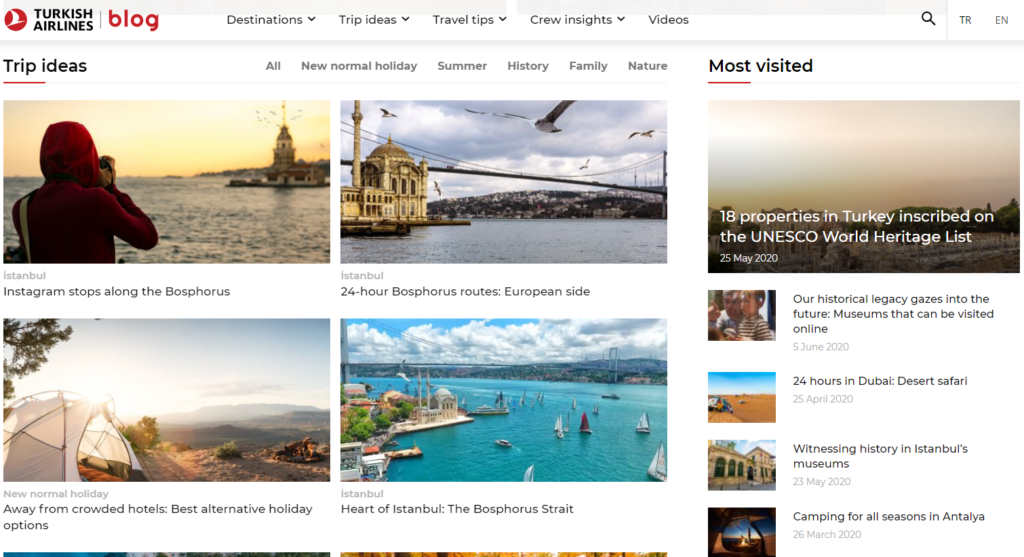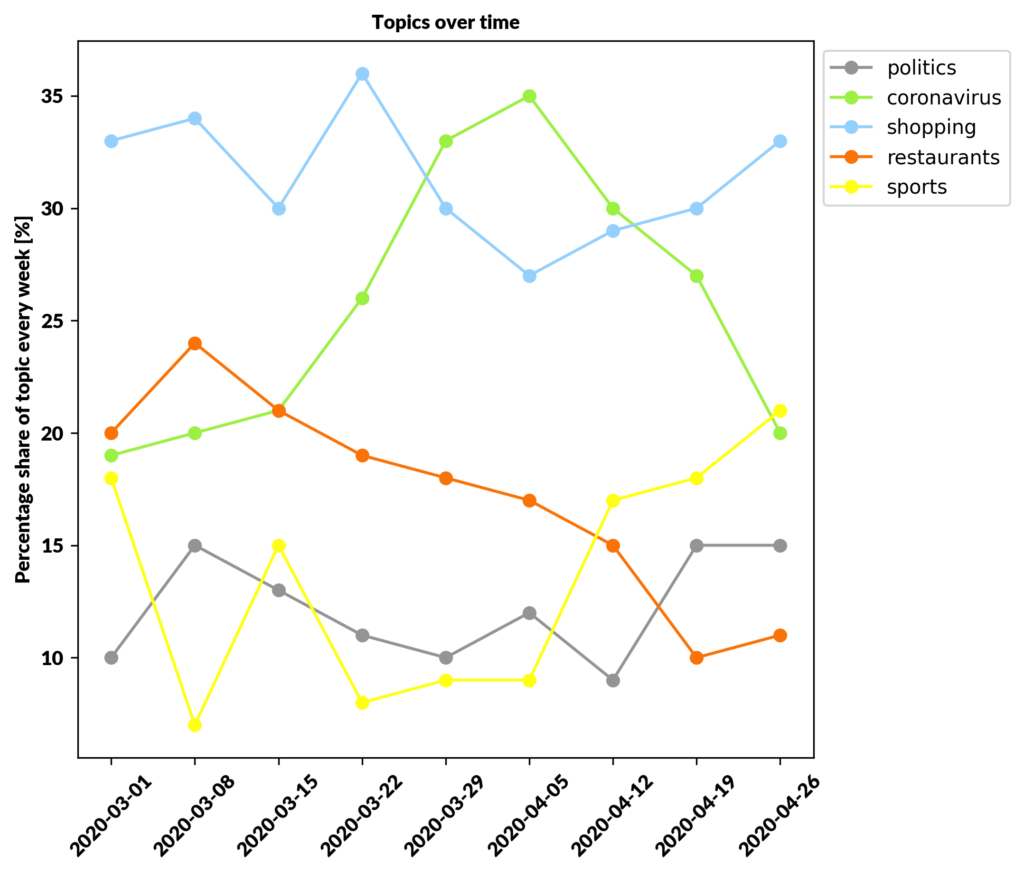Content marketers tend to rely on native social media analytics to make decisions about their content strategy. However, many of these tools don’t answer some of the more difficult questions. This is where AI and machine learning come in, and can answer nuanced questions about your content strategy.
A successful marketing strategy should include more than just one form of media. The idea is to have an omnichannel approach so that you can maximize reach for your target audience. However, each of these channels has a different purpose and audience. Your followers on Instagram probably follow you for different reasons than those that subscribe to your blog updates.
It would take a very long time to compile all of the data from your different channels, and not all of the free tools at your disposal will be able to give you deeper insights. AI can get you the right type of data, analyze it, and prepare it in a way that you can draw meaningful conclusions from.
In this article, we’ll cover:
- how often branding appears in your content,
- what did your fans/followers talk about on your posts,
- and the sentiment of the discussions on your posts.
But before going on about what AI can tell you specifically, we’ll have to explain the differences between content and social media marketing.
Content marketing and social media marketing
There are some pretty clear differences between the two, but there is also a lot of overlap. Social media marketing is mostly concentrated on social media platforms, while content marketing includes your brand’s website and other platforms where they publish. Obviously, if you’re active on social media (and you should be), you should share your content on your pages and profiles. This is one of the best ways to keep your audience aware of your brand, what you do, and get them to interact with you.
The content that you typically see on a company’s website is meant to capture new leads or convince the reader that your business can fulfill their needs. The reader finds an eBook, an analysis, or a case study that showcases your product or service, so they’ll eventually decide to try out your company’s solutions. You can’t really fit so many characters, images, or embeddings into a social media post or tweet, so a blog is your best bet.

Content on Turkish Airlines’ blog

Social media posts with short captions and links to the main page
You can repost this type of content on social media and eventually get a discussion going. After all, Jay Baer pointed out that social media can be a customer support channel and a place where customers can talk to each other or a brand. You should really integrate the two as part of your communication to get the best of both.
Now that you can tell the two apart and see how they can overlap, we can look at some of the questions AI can answer about your content strategy that you might not otherwise find out.
How often do users get exposed to branding
Around 74% of users said they see way too many ads and 63% said they repeatedly see the same things being advertised. The takeaway is that people are fed up with seeing the same promotional content over and over again. Even if these ads are effective, you still need to consider how it will influence the relationship between your company and customers. It’s really about quality, not quantity.
Some marketers and content creators hardly ever make their content seem promotional, and others are very bold about showing off symbols of their brand, such as logotypes. There is no definitive answer to the question if including brand marketing into your content strategy is good or bad, it just depends on several factors that are different between industries and brands.
For example, having an influencer or content creator become part of your content strategy could mean that you expect them to post about your brand or include product placement in their own posts. You should keep in mind that users could still see your or a brand ambassador’s organic posts as being too promotional, even if they aren’t explicit ads about your brand.
In our previous analysis on logotypes and influencer engagement, more logotypes didn’t always mean worse or better engagement. Only a couple of influencers were negatively impacted by the number of logotypes in their content. Still, it’s worth looking into how often, and for how long, your logotypes appeared in your content and cross-checking it with other metrics or analyses.
Here’s an example of how AI can be used to detect logotypes in your content, whether it’s in video or image formats.
Sotrender’s logotype detection in videos

Sotrender’s logotype detection in images
What conversations did your content inspire and what they want to see more of
You want to plan your content in a way that will keep your audience engaged. So, you need to know what topics they want to read about and talk about, but engagement metrics in analytics tools can’t analyze all their comments or feedback. In that case, you might want to look into topic modeling.
Topic modeling is used to analyze texts and eventually extract overarching topics from them. If your comments frequently mention words like Coronavirus, hygiene, and precautions, then topic modeling could help you conclude that your audience wants to know more about the overarching topic of COVID safety, for example.

Extracting topics from conversations could help inspire you to prepare more relevant content. It’s also helpful to keep track of how topics change over time, so you’ll be able to plan ahead or change your content strategy accordingly.
If the discussions that are going on are positive, negative, or neutral
It’s true that analytics tools can show you what posts got higher engagement, but they can’t tell you whether all interactions were positive or negative, and what trends they followed. Getting to know what kind of experience your customers had through their discussions can help you become more reliable and trustworthy to them.
Establishing yourself as a trustworthy brand that provides quality services and customer support should be your priority. There are different methods to check if you’re on the right track and to get specific feedback that will improve your customer experience. Think of it as an extension of reviews on sites like Google Maps, Yelp, or TrustPilot, but you need to be even more vigilant on social media because customers expect answers ASAP.
Here are two ways that you can check what is being said on your brand’s posts.
Sentiment analysis
Sentiment analysis is easy enough to understand. An AI model has learned that some words, phrases, and symbols have a positive, negative, or neutral emotional charge, and it tells you with a level of confidence what the emotional charge of the text is. That means that you can analyze texts such as articles, tweets, comments, and even larger texts.

In short, you can learn which of your content got a larger proportion of negative, neutral, or positive sentiment. You might notice that positive sentiment rose one day, check the date that this spike occurred, and check what you posted on that day. What’s more, checking how sentiment changed over time can tell you if your content strategy is headed in the right direction. If there’s an increase in negative sentiment in what users are saying, you need to rethink what you post.
Hate speech analysis
Unfortunately, there will be times when the content of users’ comments will not be as constructive or polite. This is something you can expect when many users are anonymous and don’t have to face consequences for what they say online. You might need to make use of hate speech and bullying detection models to scan users’ comments, especially if you’re posting about sensitive content.
With the help of NLP, these models are able to detect harmful content automatically. Sotrender’s ML models, for example, included special tokens like emojis, hashtags, and phrases that are relevant for social media. This ultimately makes it easier to find the mean-spirited speech on different platforms and find ways to moderate it.

We recommend using these types of models because they can help you identify content that can harm both your company’s image and your users. The goal of your content is to bring value to your users, not distress.
Improve your content strategy and get ahead
The success of your content strategy can’t be proven with analytics metrics alone. The native tools on Facebook, Instagram, or Google Analytics tied to your website, can’t tell you about nuances. Thanks to machine learning, it’s possible to use various models that will provide insights and solutions specific to your company.
AI can help you get the bigger picture of what’s going on with your content strategy and what users are saying about your brand. Knowing the answers to the questions we’ve covered will help you develop a better content strategy and save you time and energy in the long run.
If any of this sounds interesting to you, feel free to check out what other types of AI marketing analyses we could run for you. Check out our AI research page for more information, and contact our Sales Team via email. 🙂
If you want to learn more about AI in marketing, we recommend reading our other articles on the topic here:



